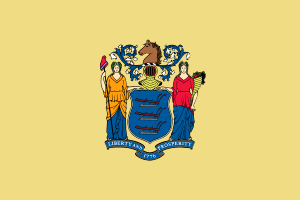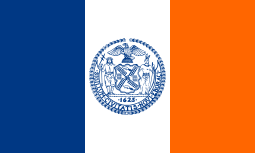Goethals Bridge
| Goethals Bridge | |
|---|---|
|
The Goethals Bridge, seen from Staten Island | |
| Coordinates | 40°38′09″N 74°11′49″W / 40.635833°N 74.196944°WCoordinates: 40°38′09″N 74°11′49″W / 40.635833°N 74.196944°W |
| Carries |
4 lanes of |
| Crosses | Arthur Kill |
| Locale | Elizabeth, New Jersey and Howland Hook, Staten Island, New York, United States |
| Maintained by | Port Authority of New York and New Jersey |
| Characteristics | |
| Design | Cantilever bridge |
| Total length | 7,109 ft (2,167 m)[1] |
| Width | 62 ft (19 m)[1] |
| Longest span | 672 ft (205 m)[1] |
| Clearance above | 14 ft (4.3 m) |
| Clearance below | 140 ft (43 m)[1] |
| History | |
| Opened | June 29, 1928 |
| Statistics | |
| Daily traffic | 78,291 (2010)[2] |
| Toll | (eastbound only) As of 6 December 2015; Cars $15 for cash, $12.50 for Peak (E-ZPass), $10.50 for off-peak (E-ZPass) |
 Goethals Bridge Location in New Jersey and New York  Goethals Bridge Location in New Jersey and New York  Goethals Bridge Location in New Jersey and New York  Goethals Bridge Location in New Jersey and New York | |
The Goethals Bridge /ˈɡɒθəlz/ connects Elizabeth, New Jersey, to Staten Island, New York, in the United States. It crosses a strait known as Arthur Kill. Operated by the Port Authority of New York and New Jersey (PANYNJ), the span was one of the first structures built by the PANYNJ. On the New Jersey side it is located south of Newark Liberty International Airport. The bridge has been grandfathered into Interstate 278, and named for Major General George Washington Goethals, who supervised construction of the Panama Canal and was the first consulting engineer of the PANYNJ.
Design
A steel truss cantilever design by John Alexander Low Waddell, who also designed the Outerbridge Crossing, the Goethals is 672 ft (205 m) long central span, 7,109 feet (2,168 m) long in total, 62 feet (19 m) wide, has a clearance of 135 feet (41.1 m) and has four lanes for traffic.[3] The Port Authority had $3 million of state money and raised $14 million in bonds to build the Goethals Bridge and the Outerbridge Crossing; the Goethals bridge construction began on September 1, 1925 and cost $7.2 million. It and the Outerbridge Crossing opened on June 29, 1928.[4] The Goethals Bridge replaced three ferries and is the immediate neighbor of the Arthur Kill Rail Bridge. Its unusual[3] mid-span height was a requirement of the New Jersey ports. The bridge was named for Major General George Washington Goethals, who supervised construction of the Panama Canal and was the first consulting engineer of the PANYNJ.[5]
Connecting onto the New Jersey Turnpike, it serves as one of the main routes for traffic between New Jersey and Brooklyn via the Staten Island Expressway and the Verrazano–Narrows Bridge. Until the Verrazano-Narrows Bridge was completed in 1964 the Goethals Bridge never turned a profit. The same happened to the Outerbridge Crossing. The total traffic in 2002 was 15.68 million vehicles.
The Goethals Bridge holds two 10-foot-wide (3.0 m) lanes in each direction, which do not meet the 12-foot (3.7 m) requirement of modern highway design standards. The bridge also has no shoulders for emergency access, or pedestrian walkways or bike paths. A completely new bridge that will address these deficiencies is now under construction. An initial study in 1997 concluded that the optimal solution would be a parallel span. However, a more recent study suggested that the existing span had only 10 years of life left, even with the recent deck rehabilitation, and that the optimal solution was an entirely new span. The choosing of the full replacement option was followed by the submittal of several design alternatives, alongside a "no build" option. It is likely that a new bridge would also include additional lanes of traffic, high-speed E-ZPass lanes, and a reconstruction and widening of Interstate 278 from exit 4 in New York (NY 440 South) to NJ 439 in New Jersey.
Bridge replacement


The bridge is slated to be replaced by late 2018.[6] The new bridge will restore [7] pedestrian and bicycle access.[8] It will be a cable-stayed bridge and will have three 12-foot travel lanes in each direction, a 12 feet (3.7 m) outer and 5 feet (1.5 m) inner shoulder in each direction, and a 10 feet (3.0 m) walkway/bikeway on the New Jersey-bound side of the bridge. In addition, there will be an area between the eastbound and westbound roadways capable of accommodating a possible future mass transit link.[9]
The initial alternatives put forth in summer 2006 included the option of twin three-lane replacement bridges north and south of the current alignment, which was completely eliminated; and twin three-lane replacement bridges (one south, and one along the current alignment), with the latter being built after the demolition of the current bridge, which was refined to be a single-span bridge instead of twin bridges. The reason for the dropping of twin-bridge alternatives in fall 2007 was a request by the FAA to decrease the height of the bridge's towers to prevent interference with flights into and out of Newark Liberty International Airport. Public open houses were held in Staten Island and Elizabeth, and the Draft Environmental Impact Statement (DEIS) was issued. Formal public hearings on the DEIS were held in July 2009.[10]
All alternatives proposed that the bridge be single level, cable-stayed, double spans, separated by towers with a height of 135 feet (41 m) above the high-water mark of the Arthur Kill shipping channel. Each deck would have three 12 ft (3.7 m) lanes with a 12 ft (3.7 m) outer shoulder and 5 ft (1.5 m) inner shoulder and the northern deck would feature a 10 ft (3.0 m) pedestrian walkway. In addition, permanent access roads would be built under the bridge on land for maintenance, security, and construction purposes.[11] Lastly, space would be left to accommodate potential mass-transit services.
For mass transit, studies indicated that a bus-only lane was not economically viable but that a high-occupancy vehicle lane open to buses as well as high-occupancy autos would be appropriate during rush hours if traffic supported it. Provision for rail transit was rejected; however, planners decided that whatever alternative was constructed, the design and structural integrity should ideally be able to be retrofitted for such at a later date. The suggestion for a freight rail connection was dismissed as uneconomic.
Also as part of the construction, improvements to approaches and nearby interchanges are to be made. These will include the New Jersey Turnpike exit 13 toll plaza (and perhaps the entire interchange), the Staten Island toll plaza, and the Interstate 278/NY 440 interchange. In addition, while separate from the bridge replacement project, the New Jersey Department of Transportation may construct full movements at the Interstate 278/U.S. Route 1/9 junction to coincide with the bridge's replacement.
The new bridge was officially approved for preliminary funding by the Port Authority on April 24, 2013 and officially broke ground on May 2014.
Toll
As of December 6, 2015, the cash tolls going from New Jersey to New York are $15 for cars and motorcycles; there is no toll for passenger vehicles going from New York to New Jersey. E-ZPass users are charged $10.50 for cars and $9.50 for motorcycles during off-peak hours (outside of 6–10 a.m. and 4–8 p.m. on the weekdays; and outside of 11 a.m.–9 p.m. on the weekends) and $12.50 for cars and $11.50 for motorcycles during peak hours (6–10 a.m. and 4–8 p.m. on the weekdays; and 11 a.m.–9 p.m. on the weekends).[12]
In popular culture
The Goethals Bridge is featured in the opening credits of The Sopranos.
See also
-
 Bridges portal
Bridges portal -
 New Jersey portal
New Jersey portal -
 New York portal
New York portal -
 New York City portal
New York City portal - List of bridges documented by the Historic American Engineering Record in New Jersey
- List of bridges documented by the Historic American Engineering Record in New York
References
- 1 2 3 4 "Facts & Info - Goethals Bridge". Port Authority of New York & New Jersey. Retrieved 2010-02-27.
- ↑ "2010 Traffic Data Report for New York State" (PDF). New York State Department of Transportation. Appendix C. Retrieved 2010-02-27.
- 1 2 Jackson, Kenneith T.; New York Historical Society (1995). The Encyclopedia of New York City. New Haven: Yale University Press. p. 471. ISBN 0300055366.
- ↑ "Two Bridges Open Over Arthur Kill. Traffic Between Staten Island and New Jersey Begins at 5 A.M. Without Ceremony. New Bus Service Starts. Borough President Lynch Will Ask Legal Action to Bar It as Bad for Business.". The New York Times. June 30, 1928. p. 35. Retrieved 2010-02-27.
- ↑ "Happy Bridge Birthday". Staten Island Advance. June 27, 2008. Retrieved 2010-09-16.
The Goethals Bridge, which links Elizabeth, N.J., with Mariners Harbor across the Arthur Kill, was named in memory of Major General George Washington Goethals. Goethals was the builder of the Panama Canal, and served as the first consulting engineer of the Port Authority.
- ↑ Higgs, Larry (April 25, 2013). "Port Authority planning its first new bridge since 1930s". Asbury Park Press. Retrieved 2013-04-30.
- ↑ "Long Distance Voyager". Retrieved 2012-12-04.
- ↑ "Bridges and Tunnels". Retrieved 2012-12-04.
- ↑ "Goethals Bridge Replacement". Retrieved 2012-12-04.
- ↑ "Draft EIS Published". Retrieved 2012-12-04.
- ↑ "Refinement of Alternatives for EIS Analysis" (PDF). Retrieved 2012-12-04.
- ↑ "New Toll Fare Rates for the Bridges & Tunnels Effective December 6, 2015 at 3:00 AM". Port Authority of New York & New Jersey. Retrieved 2015-11-23.
External links
| Wikimedia Commons has media related to Goethals Bridge. |
- Goethals Bridge
- Goethals Bridge Replacement
- Historic American Engineering Record (HAER) No. NY-305, "Goethals Bridge"
- Goethals Bridge at Structurae